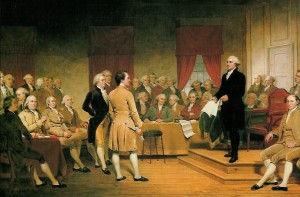The New York State
Constitutional Convention Clearinghouse
Information Related to New York's Nov. 7, 2017 Constitutional Convention Referendum
From the Governor ‘s 2010 Campaign Platform:
The New NY Agenda: A Plan for Action
In order to achieve lasting reform in many areas, we need to amend our State’s Constitution. Specifically, a Cuomo Administration [will] work to enact into law important reforms at a constitutional convention including an overhaul of our redistricting process, ethics enforcement, and succession rules, among others.
Past constitutional conventions have resulted in transformative change in times of crisis. For example, the 1777 Convention, convened in the midst of the Revolutionary War, yielded New York State’s first Constitution, a document that predates the United States Constitution by a decade. Similarly, the 1938 Convention, held in the wake of the Great Depression, produced amendments protecting the rights of working men and women and recognizing that aid for the needy is a constitutional right. A new constitutional convention could be the vehicle for critical reforms to our State government.
At the same time, prior to the constitutional convention it is widely agreed that the delegate selection process must be reformed to prevent such a convention from simply mirroring the existing political party power structure rather than the diversity of people of New York State. Many fear as well that a constitutional convention would allow damaging changes to be made to existing protections in the Constitution for civil rights, the environment, and educational rights. Before we convene a convention, these concerns must be addressed fully to ensure that the desire for reform in certain areas does not lead to the loss of past reforms in other areas.
As Governor, Andrew Cuomo will address the many necessary reforms to our Constitution in the following ways:
First, we must reform the delegate selection process and then immediately convene a constitutional convention. Through relaxed ballot access requirements, public campaign financing, limitations on legislators, lobbyists, and party officials from serving as delegates, and other reforms, the convention delegate selection process must be improved. Once that has occurred, we should convene a constitutional convention to address the many areas of reform that cannot be addressed by statutes alone.
Second, prior to the constitutional convention, we should create a constitutional commission to help define the constitutional convention and issues that need to be addressed, including recommending amendments for passage. That blueprint will then provide the starting point for both the constitutional convention and any amendments made via voter approval at the ballot box. While less well-known than constitutional conventions, these commissions have been key tools used to amend our Constitution. In the words of New York State Constitution scholar Peter Galie, “the constitutional commission has a long and vital history as a means of proposing meaningful and necessary reform within the state. Some of the most significant constitutional revision in New York has been the product of such commissions….” Created by an executive order or with the Legislature by statute, this commission will include the best and the brightest of reformers, legal experts, and statespersons and will be independent from those who created the commission.
Together, they will secure public input to develop and draft the reforms addressed in this book to create a precise blueprint for constitutional reform.
Source: Cuomo, Andrew, The New NY Agenda: A Plan for Action, Cuomo 2010, pages 28-32. Also included in a later edition, Clean Up Albany: Make it Work, Cuomo 2010, pages 71-4.
